
Transcription
State of Phone Justice:
Local jails, state prisons and private phone providers
by Peter Wagner and Alexi Jones
February 2019
Press release
At a time when the cost of a typical phone call is approaching zero, people behind bars in the U.S. are often forced to pay astronomical rates to call their loved ones or lawyers. Why? Because phone companies bait prisons and jails into charging high phone rates in exchange for a share of the revenue.
The good news is that, in the last decade, we've made this industry considerably fairer:
* The Federal Communications Commission (FCC) capped the cost of out-of-state phone calls from both prisons and jails at about 21 cents a minute;
* The FCC capped many of the abusive fees that providers used to extract extra profits from consumers; and
* Most state prison systems lowered their rates even further and ALSO lowered rates for in-state calls. (1)
However, the vast majority of our progress has been in state-run prisons. In county- and city-run jails - where predatory contracts get little attention - instate phone calls can still cost $1 per minute, or more. Moreover, phone providers continue to extract additional profits by charging consumers hidden fees (2) and are taking aggressive steps to limit competition in the industry.
These high rates and fees can be disastrous for people incarcerated in local jails. Local jails are very different from state prisons: On a given day, 3 out of 4 people held in jails under local authority have not even been convicted, much less sentenced. The vast majority are being held pretrial, and many will remain behind bars unless they can make bail. Charging pretrial defendants high prices for phone calls punishes people who are legally innocent, drives up costs for their appointed counsel, and makes it harder for them to contact family members and others who might help them post bail or build their defense. It also puts them at risk of losing their jobs, housing, and custody of their children while they are in jail awaiting trial.
Over time: Phone rates in prisons and jails
National survey results for 15 minute calls, 2008-2018
[line graph]
The cost of calls home from state prisons has declined as a result of the FCC's caps and political pressure from the families, but jails still lag far behind. In fact, we estimate that approximately half of the small rate drop shown for jails is due to changes in data and methodology between the 2016 and 2018 surveys and may not reflect an actual drop in prices. (Shown are 6 national surveys of out-of-state calls from state prisons, 7 surveys of in-state calls from state prisons, and 2 surveys of in-state calls from jails. For more information about these surveys, see methodology). To see the states with the most significant rate drops, see Appendix Table 1.
It is well within the power of both prisons and jails to negotiate for low phone rates for incarcerated people, by refusing to accept kickbacks (i.e. commissions) from the provider's revenue and by striking harder bargains with the providers. And many state prisons have done so: Illinois prisons, notably, negotiated for phone calls costing less than a penny a minute.
But in Illinois JAILS - which are run not by the state but by individual cities and counties - phone calls cost 52 times more, with a typical 15-minute call home from a jail in Illinois costing $7. In other states, the families of people in jail have to pay even more: A call from a Michigan jail costs about $12 on average, and can go as high as $22 for 15 minutes (compared to $2.40 from the state's prison system).
On average, phone calls from jail cost over three times more than phone calls from state prisons. Nationally, the average cost of a 15-minute call from jail is $5.61. This table and the map below show just how much more local jails are charging in each state than state prisons for the same 15 minute in-state phone call:
[table of states and costs]
The highest cost of a 15-minute call from a local jail by state
[map of the United States with prices on each state]
As of November 2018, in more than half of states, the highest in-state 15 minute call costs more than $10, and in 15 states it costs over $15. (Alaska, Connecticut, Delaware, Hawaii, Rhode Island, and Vermont do not have jails and are therefore not displayed). For the names of the facilities that charge the most in each state, see Appendix Table 3.
Why jails find exploitative contracts attractive - and how providers ultimately profit the most. A Michigan analysis (expand)
What accounts for these vast price disparities? Local jails are not significantly more expensive to serve than state prisons. Rather, phone providers have learned how to take advantage of the inherent weaknesses in how local jails, as opposed to state prisons, approach contracting. The result is that jails sign contracts with high rates that are particularly profitable for the providers.
State prisons have, compared to jails, several advantages:
* State prisons, which are larger than jails, have the means to analyze the costs and benefits of proposed contracts (and often write their own contracts). Their analyses can reveal hidden fiscal and policy costs underlying too-good-to-be-true vendor proposals.
* State prisons tend to be run by appointees of the Governor, so they are often insulated from short-term financial and political pressures, and are often supported by career staff who have years of experience negotiating with billion-dollar communications companies.
* The typical prison sentence is about 29 months (8) so the families of people in prison can put sustained political pressure on the prison system to negotiate fairer prices (9).
* Many state legislatures have passed laws lowering the cost of calls home from state prisons. (10)
Jails, meanwhile, are vulnerable to signing bad contracts because:
* County jails tend to be smaller, (11) and unless they rely on expensive consultants, their staff will have a harder time negotiating sophisticated telecommunications contracts, and may even rely on language suggested by the providers.
* Local governments (which run jails) tend to have smaller or less flexible budgets and are less eager to think long-term than state governments (which run prisons). And in particular, when jails are run by ELECTED officials, they may not be looking beyond the next election.
* The typical person booked into a jail is released in hours or days and may make only a few calls, so it is difficult for their families to put sustained political pressure on jail administrators to negotiate better contracts.
* Many state legislatures - and by extension the Public Utility Commissions and other regulatory and civil society organizations - pay very little attention to individual jails or the state's aggregated jail policy.
So to recap, the companies are savvy and very effective at cutting self-serving contracts with the jails. But in addition to their high rates in jails, companies also slip in hidden fees that exploit families and, as we will see, shortchange facilities.
How charging families hidden fees shortchanges both families and facilities
Phone providers are counting on facilities, regulators, legislators, journalists and the readers of this report to focus only on per-minute phone rates, ignoring their other major source of revenue: fees.
Because the typical reader unfamiliar with telecommunications regulations would assume that rates and fees are the same thing, it is helpful to step back and clarify our definitions:
Rates:
This is what you pay per minute, including any higher charge for the first minute of the call.
Fees:
This is everything else you might pay for "services" related to the call, such as fees to open an account, have an account, fund an account, close an account, get a refund, receive a paper bill, etc.
Charging high consumer fees allows phone providers to technically abide by rate caps while generating a new source of revenue - one on which, as a bonus, they do not have to pay commissions to facilities. As long as these fees are ignored or dismissed as an "ancillary" issue, companies will continue to use them as - in the FCC's words - "the chief source of consumer abuse". Historically, these fees are not trivial, but "can increase the cost of families staying in touch... by as much as 40%."
To its credit, the FCC made tremendous progress on this issue in 2015, capping some fees and eliminating others. (12) Just one of the reforms - capping the fee charged for a credit card purchase (to a still significant $3.00) (13) - has saved consumers $48 million every year since. (14)
Sadly, the most unscrupulous providers have found ways to evade these new regulations, and continue to charge unconscionable fees.
For example, many people living in poverty (who are among the most likely to be incarcerated or have incarcerated loved ones) do not have bank accounts and often pay their bills by money transfer via Western Union or Moneygram. (15) Western Union and Moneygram charge a standard price of about $6.00 (16) to send a payment to most companies, including GTL, (17) NCIC, Telmate, Paytel, or IC Solutions. (See table.)
However, other companies have arranged (18) hidden profits in these third party payment systems. For the same $25 payment to Amtel, Lattice or Securus, Western Union and MoneyGram charge a shocking $10-12. The explanation is that Western Union and MoneyGram are collecting a portion of this fee on behalf of the phone providers, something that the FCC intended to prohibit. Amtel has even admitted to the FCC that it receives a portion of Western Union's fees. Western Union calls these payments a "revenue share" in its correspondence and a "referral fee" in its contracts. Families and facilities would be right to call this hidden fee a form of exploitation.
[table of providers and fees]
The fee charged by Western Union and MoneyGram to send $25 payments to each of the providers above from in-person agents in Massachusetts in December 2018 and January 2019.
[comic strip titled Captive Market]
This one can't wait to see his daddy. A few phone calls a week just aren't enough.
Phone calls!? Don't get me started. Can't believe what Securus charges for a phone call. And on top of that, every time I need to add more money to my Securus account, Western Union charges me almost 12 bucks!
Weird. My Mom uses Western Union to fund her GTL account so my sister in the jail can call us. But Western Union only charges her $6.95.
Y'all both paying too much. I use the website and my credit card. Only costs me $3.00.
Credit card? Most people I know don't have bank accounts! All I know is for every $50 I add to my Securus account, I have to pay Western Union $11.95. That's another hour of work for me just to pay that fee! Don't know who gets that money.
Hey, I had an idea. Is there a way to make a profit on both the calls and on payment fees?
Sure! We can charge high fees for website payments and credit cards on the phone. Not sure about Western Union though. Lots of poor people use that but we don't set those fees.
Who says we can't ask Western Union to charge a higher fee and share the extra profit back with us?
I don't see why not. After all, we've got a captive market.
The providers also invent new services which they call "advanced", "premium" or "convenience", but which tend to be simply more expensive ways to make families pay for the same product.
For example, Securus goes out of its way to make it hard for family members to create and fund accounts in an efficient manner. Rather than encourage families to create pre-paid accounts - or to add funds to a depleted account - Securus instead steers people to pay for each call individually. By emotionally manipulating family members into paying for single calls rather than creating accounts (see comic below), the companies drive up fee revenue. (19) Other services - such as charging families to listen to voicemails from their loved ones in jail - similarly manipulate consumers and increase revenue from fees. Neither public safety nor consumer "convenience" benefit from these unnecessary but highly profitable call products.
[comic titled Charges May Apply]
It's easy to see how the phone providers benefit from imposing a variety of burdensome fees, but how this practice also hurts facilities does not get enough attention. Facilities' commissions come from phone calls themselves, NOT the fees attached to them. Facilities should therefore want families to be making more phone calls, but when families are bled dry by high fees, the number of calls they can afford to make goes down. That outcome is fine with the providers, but leaves the facilities with less revenue than they expect. (For sheriffs who already feel uncomfortable charging families $1/minute, understanding that they, too, are being ripped off by providers should push them to negotiate for contracts that prioritize the interests of local families over large corporations.)
The providers are consolidating the market to limit facilities' choices and lock them into unfair contracts
Phone providers, as we explain above, are skilled at writing self-serving contracts that burden consumers with unfair rates and fees. It is therefore in the interest of correctional facilities to be careful and conscientious in selecting a phone contract. But the odds of negotiating a fair contract - odds already tilted against facilities, as we've shown - are declining as phone companies buy up their direct competitors and the providers of related correctional services.
First, as the below timeline illustrates, providers are limiting facilities' choice of vendor by directly purchasing their competitors:
Corporate Consolidation
How GTL and Securus came to dominate the prison and jail telecom industry
[timeline]
This timeline of mergers in the prison/jail telephone space shows how GTL and Securus have, over time, gobbled up many of their competitors. Not shown are the respective sizes (20) of each of the companies (GTL is the largest, followed by Securus and - if it were an independent company - IC Solutions), or the fact that some companies like CenturyLink operate only in partnership with Securus and IC Solutions or that for some companies (like AT&T or Verizon) only the portion of their business that was prison and jail phones was transferred. Additionally, it is possible that one corporate merger on this timeline may be undone, as Securus' purchase of IC Solutions is currently under review by the Federal Communications Commission and the Department of Justice. (21)
The fact that only two companies now control most of the correctional phone market - and are poised to control even more if Securus acquires IC Solutions - is bad news for both facilities and consumers.
But the dominant companies have a second monopoly strategy, which is both more subtle and more harmful: buying non-telephone companies, in order to offer facilities packages of unrelated services in one huge bundled contract.
Bundled contracts combine phone calls with other services, such as video calling technology, electronic tablets, and money transfer for commissary accounts. This allows providers to shift profits from one service to another, thereby hiding the real costs of each service from the facility. Bundling also "locks in" contracts for the provider: It makes it more difficult for the facility to change vendors in the future, because the facility must now change their phone, email, commissary, and banking systems all at the same time.
So even the savviest of facilities are undercutting their future power by signing risky bundled contracts.
Recommendations:
Taming the correctional phone market will require focusing on the areas where injustice is concentrated: Jails (rather than only prisons), fees (rather than only rates), and bundled contracts (rather than phone-only contracts). The bulk of the work lies with specific officials: contracting authorities, state legislatures, public utilities commissions, the FCC and Congress. For those groups, we recommend the following strategies:
Prisons and jails (and their oversight bodies):
1. Prohibit commission payments in all of their forms.
2. Negotiate better contracts based on delivering the best price to the consumer. (This goes beyond negotiating for "low" rates; and requires refusing unnecessary "extras" in the contract and looking at the total cost to the consumer, including fees.)
3. Consider making phone calls free. In July 2018, New York City went further than prohibiting a commission and pledged to make phone calls free. This saves the poorest families critical funds, is a cost-effective investment in lowering recidivism, makes the justice process fairer and, because it reduces all of the hassle associated with accounts and billing, may not cost very much.
4. Refuse to consider contracts that bundle telephone service with other goods and services. Facilities should always know what they are getting and what they - and the families - are paying for.
5. Regularly conduct realistic tests of how your provider charges and treats consumers. Such tests should include test phone calls to staff phone numbers not already in the provider's system and should include test deposits made via the mechanisms most likely to be used by the families of incarcerated people, including Western Union and MoneyGram. If you discover your provider is charging consumers beyond the fees and rates disclosed in your contract, demand that the provider make refunds.
Providers:
1. Amtel, Lattice and Securus should stop making a profit on Western Union and MoneyGram payment fees. The consumers that use these services are among the lowest-income people in the country and should not be a target for exploitation.
2. All providers should explore and promote alternative and lower-cost ways for low-income consumers - their target demographic - to pay for services. In particular, their customers who do not have bank accounts or credit/debit cards often pay the providers via Western Union or MoneyGram, which offer a network of retail locations to take cash to pay bills, but services like PayNearMe (22) can provide the same functionality at a much lower cost.
3. During the request for proposals process, be honest with the facilities that high rate/high-commission contracts are not in the facility's best interests. Explain that low-rate/low-commission contracts produce comparable revenue for the facilities while increasing family contact.
State Public Utility Commissions:
1. Follow the lead of Alabama and craft comprehensive regulation of the prison and jail telephone industry operating in your state.
2. If your state statutes do not grant you sufficient regulatory authority over the industry, immediately go to the legislature and request it so that consumers and facilities in your state will not remain defenseless.
State legislatures:
1. Require these correctional communications contracts be negotiated on the basis of the lowest price to the consumer. (This goes beyond setting a cap or banning "commissions"). Ensure that these rules apply to both prisons and jails.
2. Alternatively, consider establishing a system that sets a maximum commission amount on a per minute basis - at for example 1 cents a minute - in order to give jails an economic incentive to both increase call volume and keep the total cost to consumer low now and in the future.
3. Require the state prison system to negotiate its contract to give county jails the option to opt in to the state contract and its terms. (23) Depending on the number of counties in a state and the resources of each county; this could be a powerful way to reduce a burden on county jails while lowering the cost to families.
4. Encourage the State Public Utility Commission to investigate and regulate the prison and jail telephone industry. Be on the lookout for arguments from providers that they are exempt from regulation because they claim to be providing Voice Over Internet Protocol (VOIP) or Internet Protocol-enabled (IP-enabled) services. (Some states deregulated these services when cable telephone markets became competitive, but such reregulation should not apply in a quintessential monopoly such as prison and jail phone service.) Depending on your state, you may want to encourage your Public Utility Commission to reject such arguments as contrary to legislative intent, or you may need to pass clarifying legislation.
FCC:
1. Return to actively investigating the industry. When Chairman Pai was Commissioner Pai, he opposed the majority's proposal for how to regulate the industry, but he agreed that the market was dysfunctional and in need of active regulation. (24) Now that he is Chairman of the FCC, he can plot a course to regulate the industry that is consistent with his view of the limits of the FCC's power. (25)
2. Reject Securus' application to merge with IC Solutions.
3. Investigate Amtel, Lattice and Securus for arranging a kickback with Western Union and MoneyGram in violation of the FCC's order prohibiting marking up those money transfer fees.
Congress:
1. Pass legislation like the last Congress' S. 2520 Inmate Calling Technical Correction Act which would clarify the FCC's authority to regulate both in-state and out-of-state calls, fees, and advanced technology like video calling.
Appendices and Exhibits:
Appendix Table 1
[table of states, call costs in 2008 and 2019, and rate drops]
Drops in instate state prison rates over the last decade.
Appendix Table 2:
2018 Phone Rates Survey (1,892 local jails)
Appendix Table 3:
The most expensive jail phone calls in each state
Appendix Table 4:
Historical state prison phone rates, 2008-2019
Appendix Table 5:
Commission totals for select counties in Michigan, 2014-2018
Appendix Table 6:
Phone numbers for governor officers in each state, as of 2016 (for use as in-state phone numbers on provider websites.)
Appendix Table 7:
Phone rates and average daily population in Michigan jails
Appendix Table 8:
Phone industry timeline details [xlsx]
Appendix 9:
How rates compare between urban and rural counties, with national data and graphs for California, Colorado, Illinois, Iowa, and Ohio.
Appendix 10:
Captive Market comic description
Appendix 11:
Charges May Apply comic description
Exhibits
* Exhibit 1: Genesee County Michigan contract amendment after the FCC's 2015 cap on fees went into effect
* Exhibit 2: Email from Olga Rombach, Western Union National Account Executive to Karen Doss Harbison of AmTel, Re: FCC, September 3, 2014
* Exhibit 3: Amended Contract between Amtel (dba ATN) and Western Union, 2015 showing that in Alabama, Amtel will no longer be receiving a "referral fee" from Western Union.
Methodology
This report, its visuals and its appendices pull together several different surveys of rates:
* 2008 prisons: Prison Legal News collected the collect call rates in effect during 2007-2008. (At this time, most calls from prisons and jails were made collect.)
* 2013 prisons: Prison Legal News surveyed rates in 2012-2013. This survey is based on pre-paid rates, which was, by this time, the most common type of call from prisons and jails.
* 2014 prisons: We collected out-of-state rates and in-state rates by two different methodologies. Unfortunately, there is no singular survey of rates in 2014; but the PrisonPhoneJustice.org website (run by Prison Legal News) was keeping this website up to date with rate information on a rolling basis. This invaluable data collection is available historically through the Internet Archive at https://web.archive.org/web/20140514050002/https://www.prisonphonejustice.org for May 14, 2014. Unfortunately, while PrisonPhoneJustice.org was collecting both collect and prepaid rates, only the in-state collect rates were available in this particular archive. To make the in-state rates comparable with the more common prepaid rates, we reduced the collect rates by 15%. (We note that in Prison Legal News' 2012-2013 survey, prepaid rates were, with few outliers, typical 80-90% of collect rates, so we used the average difference of prepaid being 15% cheaper than collect. Additionally, we concluded that this assumption was reasonable because when the FCC set their rate caps in 2013, they set the prepaid cap of 21c at 15% lower than the collect rate of 25c a minute.)
For the out-of-state rates in 2014, we adjusted the 2013 survey data discussed above to make all states compliant with the new FCC out-of-state rate caps that went into effect in February 2014, limiting the cost of an out-of-state 15-minute call to $3.15. If states' interstate caps were already below $3.15, we assumed their rates remained the same. Although we do not recall any instances of this, it is possible that some states may have taken the opportunity to immediately lower rates more than was required, and it is possible that our average of $2.80 is a slight overestimate.
* 2015 prisons (in-state calls only): We used the same methodology and adjustments as described above for 2014, using the Internet Archive of PrisonPhoneJustice.org for January 26, 2015: http://web.archive.org/web/20150126120301/https://www.prisonphonejustice.org/. (Out-of-state rate data is not available for 2015. Once the FCC's out of state rate caps went into effect, much of the movement's attention turned to in-state calls and out-of-state data does not appear to have been preserved.)
* 2016 prison and jail rates (in-state calls only): We used prison and jail intrastate prepaid rates data collected November 28 - December 12, 2016 by Lee Petro, former counsel for the Wright Petitioners, and the Prison Policy Initiative and made available in a submission to the FCC. Some counties had multiple facilities which were listed separately, but to make the dataset comparable, we merged those facilities together into one county entry for the purposes of our averages. We also removed police departments. This survey did not include many of the smaller companies such as NCIC, Correct Solutions, City TeleCoin, Lattice, AmTel, etc.; and did not include Telmate's facilities because at the time, Telmate did not publish their rates online. (Like in the previous year, out-of-state data is not available for this year.)
* 2017 prisons: For 2017 in- and out-of-state rates, we used historical prepaid rate data available at prisonphonejustice.org. Each state page provides phone rates from previous years. For example, Maryland's historical data can be found on this page: https://www.prisonphonejustice.org/state/MD/history/.
* 2018 prisons: We manually looked up prepaid rates (26) on providers' websites for both intrastate and interstate calls in October of 2018. For intrastate calls, we got a rate quote for a phone call to each state's governor's office, consistent with the 2016 survey methodology, and for out-of-state calls we used an out-of-state number.
* 2018 jails (in-state calls only): We manually looked up prepaid rates on providers' websites November 1st 2018 to November 8th 2018 from an in-state number (generally the governor's number) for each facility listed in the state. (This methodology may have understated the cost of in-state phone calls in a small number of counties if the facility was within the same "LATA" as the Governor's office. In those cases, our rates may report a lower "local" call rate and not a typical in-state call; but we did not have a way to control for this directly except in Michigan where we manually chose a number located in another "LATA"). As in 2017, counties that had multiple facilities were aggregated together, state prisons were kept separate from our data on jails, and we removed police departments. Some facilities are included twice because providers sometimes do not remove the rates/counties from contracts they have lost from their website. If we were unable to determine which provider currently contracts with a facility, we kept both.
The results of this survey are in Appendix Table 2, except for the NCIC facilities. (Unlike most providers, NCIC does not post their facility list or rates online. However, NCIC gave us their facility and price list so that we could calculate the average jail phone cost in each state on the condition that we not include their facility-level data in the Appendix.)
There are some slight differences in these surveys that are relevant to discuss. First, although more comprehensive than our 2016 data, this new survey is still missing data from several smaller prison phone companies that do not post their rates online, including Correct Solutions, City TeleCoin, Turnkey, Consolidated Telecom, Inc. (CTEL), etc. Second, some counties are in one survey but not the other, likely because they changed to or from a provider who does not post rates. Third, our newer survey includes two lower-cost providers that were not in the earlier survey. (Telmate's decision to finally post their rates online and NCIC's sharing of their rate data with us slightly reduces the average rates recorded. Based on our analysis of counties for whom rates are available for both years, we believe that about half of the $1 decline in the cost of in-state 15 minute phone calls from 2016 to 2018 is the result of actual declines in the rates; and about half is the result of these two lower-cost providers making their data available.
For our survey of Western Union and Moneygram fees, we collected Western Union fee data for a $25 payment to different phone providers through in-person payments at Big E's Supermarket, Easthampton, and Walgreens (225R King St., Northampton, MA) and through online chats with Western Union Representatives. We collected data on MoneyGram's fees for a $25 payment through Moneygram's online BillPay feature and in person at Walmart (337 Russell St, Hadley, MA 01035).
Our interactive feature showing how much a phone call from various local jails would cost is based on our late 2018 survey of jail rates. The feature includes only some of the highest rates from jails in each state, so for the specific rates of all facilities, see appendix 2. The feature always shows the cost of the first minute of a call for the first minute of reading the webpage, and then apportions the cost of subsequent minutes to each subsequent second. For providers who bill only on the basis of individual minutes, our feature therefore underestimates the cost of each call.
Our timeline of consolidation in the industry is built upon reviewing every document we could find and a select number of interviews. The raw data and our notes on sourcing for transaction or change in status is in Appendix 7. Wherever possible, all dates in the visual are accurate to the nearest quarter year. Because it was not always clear when these privately held companies were founded or when they entered the prison or jail phone market, we choose to represent start dates that we were not sure about with a faded line. We used a break in the line to represent companies' name changes. We did not include some very small companies, such as Michigan Paytel and American Phone Systems, some of which appeared to have substantial business relationships with large phone companies.
For the sidebar about unjustifiably high phone rates from jails, we used commission data for 2014-2018 for select companies in Michigan, which was collected via FOIA requests. With a goal of representing a range of counties, we requested records from at least 54 counties (out of 83 total) and received records from 44. This raw data is available in Appendix 5. To reduce the impact of artifacts in the data and to make it possible to compare counties of different sizes, we averaged the payments from multiple years and used the Average Daily Population reported in the Census of Jails, 2013 to calculate annual revenue per incarcerated person.
See the footnotes
Privacy policy
This report requests your location so that we can show the rates of phone calls in jails in your state. If you gave us this permission, we discarded your location data as the page finished loading. If you did not give us this permission - or if your browser was configured to decline permission automatically - this report simply makes an educated but unrecorded guess based on your IP address about what state's data you will find most relevant.
Acknowledgements
All Prison Policy Initiative reports are collaborative endeavors, and this report is no different, building on an entire movement's worth of research and strategy. For this report, we wish to single out the contributions of illustrator Kevin Pyle for explaining two of the industry's dirtiest and most complicated tricks in two comics, as well as Robert Machuga, Jordan Miner and Mack Finkel for their assistance with design and interactive functions. We also wish to acknowledge the editors at The Verge, who (in the excellent 2016 article Criminal Charges) gave us the inspiration for the phone rate clock in this report. We are also grateful to the many colleagues who helped us gather rate data, pointed us to documents on the history of companies in the prison and jail telephone industry, or reviewed drafts. The Prison Policy Initiative's Communications Strategist, Wanda Bertram, provided invaluable feedback and editorial guidance. We also have to thank our individual donors, who choose to invest in research that gives voice to the 2.3 million Americans behind bars, and who make reports like this one possible.
About the authors
Peter Wagner is an attorney and the Executive Director of the Prison Policy Initiative. He co-founded the Prison Policy Initiative in 2001 in order to spark a national discussion about the broader harms of mass incarceration. He is a co-author of a landmark report on the dysfunction in the prison and jail phone market, Please Deposit All of Your Money, and has testified in partnership with the Wright petitioners before the FCC in support of stronger market regulations. His other work includes the annual Mass Incarceration: The Whole Pie, Following the Money of Mass Incarceration, groundbreaking research on the racial geography of mass incarceration, and reports putting each state's overuse of incarceration into the national and international context. He is @PWPolicy on Twitter.
Alexi Jones is a Policy Analyst at the Prison Policy Initiative and a graduate of Wesleyan University, where she worked as a tutor through Wesleyan's Center for Prison Education. In Boston, she continued working as a tutor in a women's prison through the Petey Greene Program. Before joining the Prison Policy Initiative in 2018, Alexi conducted research related to health policy, neuroscience, and public health. Her most recent publication is Correctional Control 2018: Incarceration and supervision by state (December 2018).
Post #2
Blogs/555/
Timeline: The 18-year battle for prison phone justice
by Peter Wagner and Alexi Jones, December 17, 2018
Journalists and others often ask about how the movement for phone justice began and why this is taking so long. Here are the key dates:
2000:
Martha Wright, a grandmother who was struggling to afford calls to her incarcerated grandson, sues a private prison company over the contracts it has with various phone companies.
2001:
Federal Court grants motions by private prison company and telephone companies to refer the case to the Federal Communications Commission (FCC).
2002-2011:
For nearly 10 years, the Federal Communications Commission takes no visible action.
2012:
The Federal Communications Commission files a Notice of Proposed Rulemaking (NPRM) regarding the Wright Petition.
2013:
The Federal Communications Commission votes 2-1 to approve new regulations that set interstate rate caps of 21 cents a minute for debit and pre-paid calls and 25 cents a minute for collect calls. The one dissenting vote is from FCC Commissioner Ajit Pai, who previously represented prison phone giant Securus in private practice.
2014:
Despite legal challenges from prison phone companies, the FCC's new rate caps go into effect in February.
2015:
In October, the FCC issues additional regulations, lowering the cost for all calls from prisons (out-of-state and in-state) to 11 cents a minute, and lowering the cost of calls from jails at 14 to 22 cents a minute depending on the size of the institution. The FCC also approves comprehensive reform and caps on the cost of "ancillary fees" that can double the cost of a call. Again, Commissioner Pai voted against these regulations. Many of the phone companies, several state prison systems, county jail systems, and sheriff associations file suit challenging the FCC's order.
2016:
The federal court issues a partial stay of the Federal Communication Commission's October 2015 regulations, preventing the new rate caps from taking effect. The new regulations on fees, however, go into effect. The lawsuit moves very slowly.
2017:
In January, Donald Trump appoints FCC Commissioner Ajit Pai the Chairman of the FCC. In February, Pai, who had twice voted against regulating the industry, announces that the FCC will stop defending its in-state rate caps in court. However, the FCC does consent to 6 advocacy organizations, including the Prison Policy Initiative, defending that part of the lawsuit as intervenor-defendants. In June, despite this effort, the federal court strikes down the FCC's 2015 rate caps. The 2013 rate caps, and the 2015 fee caps, remain in place.
For more on the struggle for phone justice, see our campaign page.
Peter Wagner is Executive Director of the Prison Policy Initiative. (Other articles | Full bio | Contact)
Alexi Jones is a a Policy Analyst at the Prison Policy Initiative. (Other articles | Full bio | Contact)
Leave a Comment
Post #3
Blogs/555/
Victory for phone justice: Securus and IC Solutions abandon attempted merger
A merger between the two companies would have curtailed the ability of prisons and jails to choose a phone provider, to the detriment of incarcerated people and their families
April 2, 2019
Easthampton, Mass. - Prison phone industry giant Securus has abandoned its attempt to purchase IC Solutions, the industry's third largest company, after the Federal Communications Commission and the Department of Justice's Antitrust Division signaled that they would likely block the deal. The merger would have effectively handed the market for prison and jail phone services over to Securus and its last major competitor, GTL.
"Based on a record of nearly 1 million documents comprised of 7.7 million pages of information submitted by the applicants, as well as arguments and evidence submitted by criminal justice advocates, consumer groups and other commenters, FCC staff concluded that this deal posed significant competitive concerns and would not be in the public interest", said FCC chairman Ajit Pai in a press release.
"Securus and ICS [Inmate Calling Solutions] have a history of competing aggressively to win state and local contracts by offering better financial terms, lower calling rates, and more innovative technology and services. This merger would have eliminated that competition, plain and simple", said Makan Delrahim, Assistant Attorney General of the Department of Justice's Antitrust Division in a press release. "The companies' decision to abandon this deal is the right outcome - correctional facilities, inmates and their friends and families will continue to benefit from the robust competition between these firms."
"All too often, calls home from jails cost an unconscionable $1/minute", said Peter Wagner, Executive Director of the Prison Policy Initiative. "Had the companies merged, facilities would have had a harder time negotiating contracts with lower rates for families - which, thanks to our movement's ongoing advocacy, they're finally beginning to do."
In our objection to the merger, filed in July 2018 with a coalition of groups working for prison phone justice represented by probono attorneys Davina Sashkin and Cheng-yi Liu, we argued that the FCC should stop the merger.
We argued that Securus' history of repeatedly flouting commission rules - including deliberately misleading the FCC during a similar review last year, for which it was punished with an unprecedented $1.7 million fine - made it ineligible to purchase one of its competitors. We explained that the company has repeatedly tried to circumvent regulation in order to increase its profits from prison phone calls, and as recently as May 2018 was caught enabling illegal cell phone tracking.
Our filing included a detailed analysis of the concentration of the prison and jail telephone industry. We calculated market share in two different ways; by either measure, Securus and GTL were poised to control between 74% and 83% of the market. Except for IC Solutions - which Securus was seeking to acquire - no other company had above 3% market share.
Below is a historical timeline originally prepared for our report State of Phone Justice: Local jails, state prisons and private phone providers, showing how aggressively Securus and GTL have been gobbling up their competitors:
Corporate Consolidation
How GTL and Securus came to dominate the prison and jail telecom industry
[timeline]
For more information about this timeline, the companies, their respective sizes, the role of companies like CenturyLink that operate only in partnership with Securus and IC Solutions, or the historical role of AT&T and Verizon, see our report, the footnotes and appendices to State of Phone Justice: Local jails, state prisons and private phone providers.
Updated April 3, 2019 10am with FCC press release and 1pm with the Department of Justice's press release.
Leave a Comment
Other posts by this author
|
2023 may 31

|
2023 mar 20

|
2022 aug 23

|
2022 aug 23

|
2022 aug 23

|
2022 aug 23

|
More... |


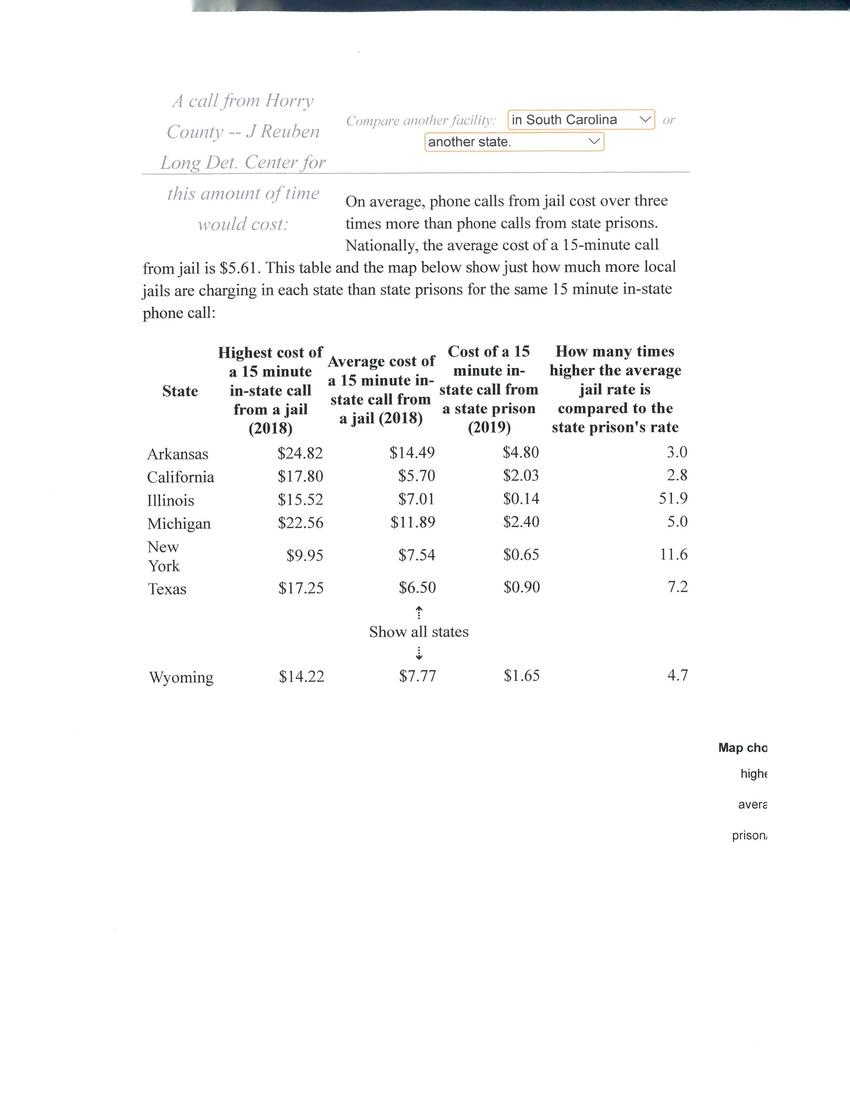
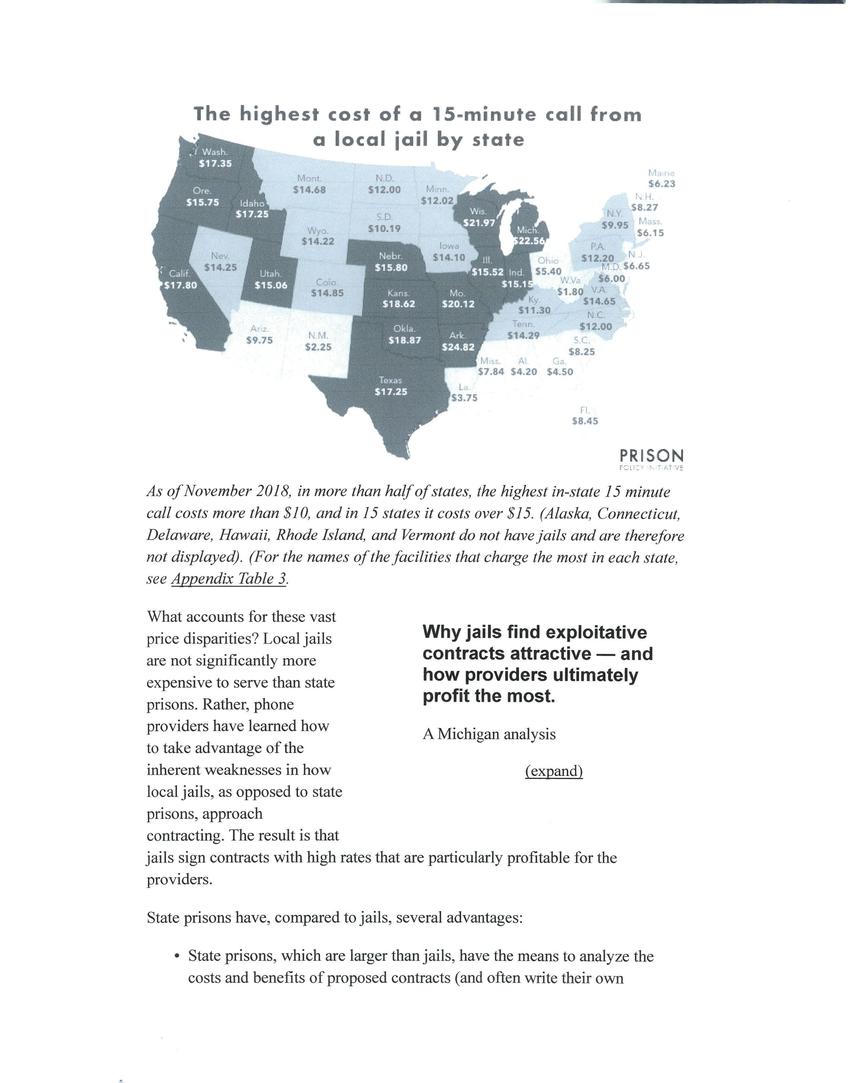
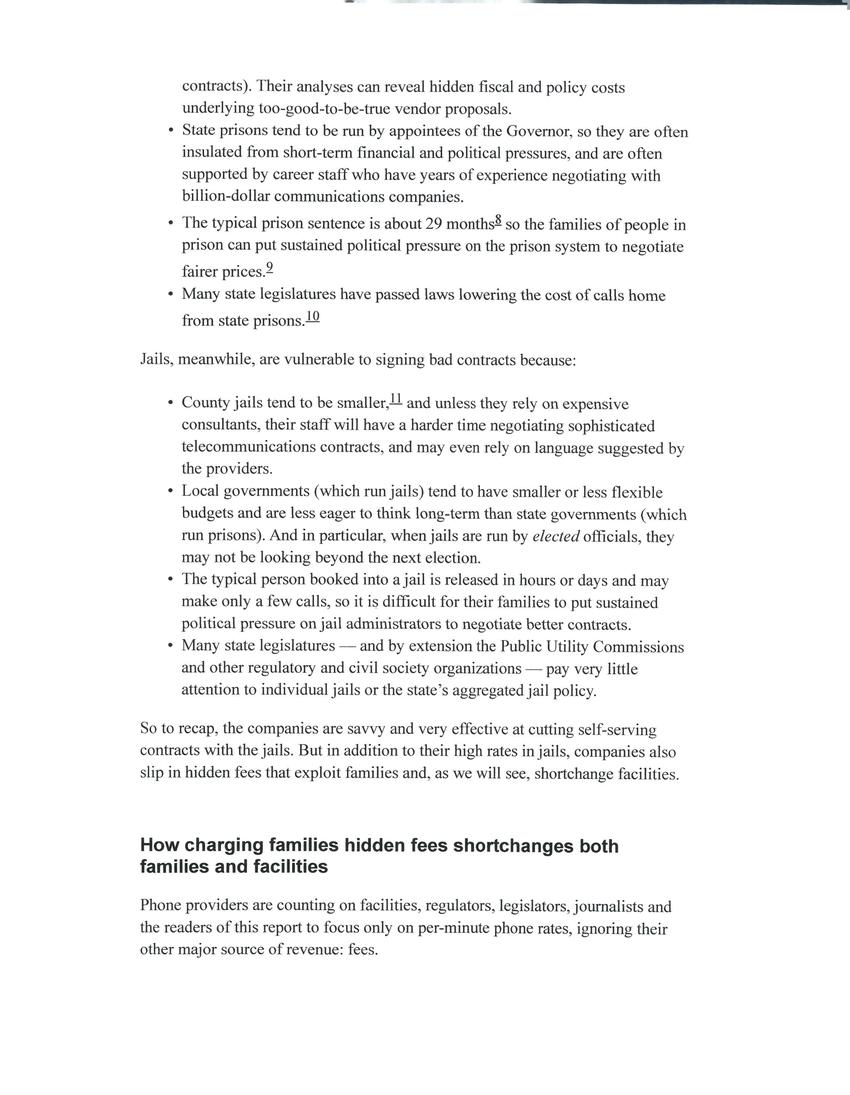

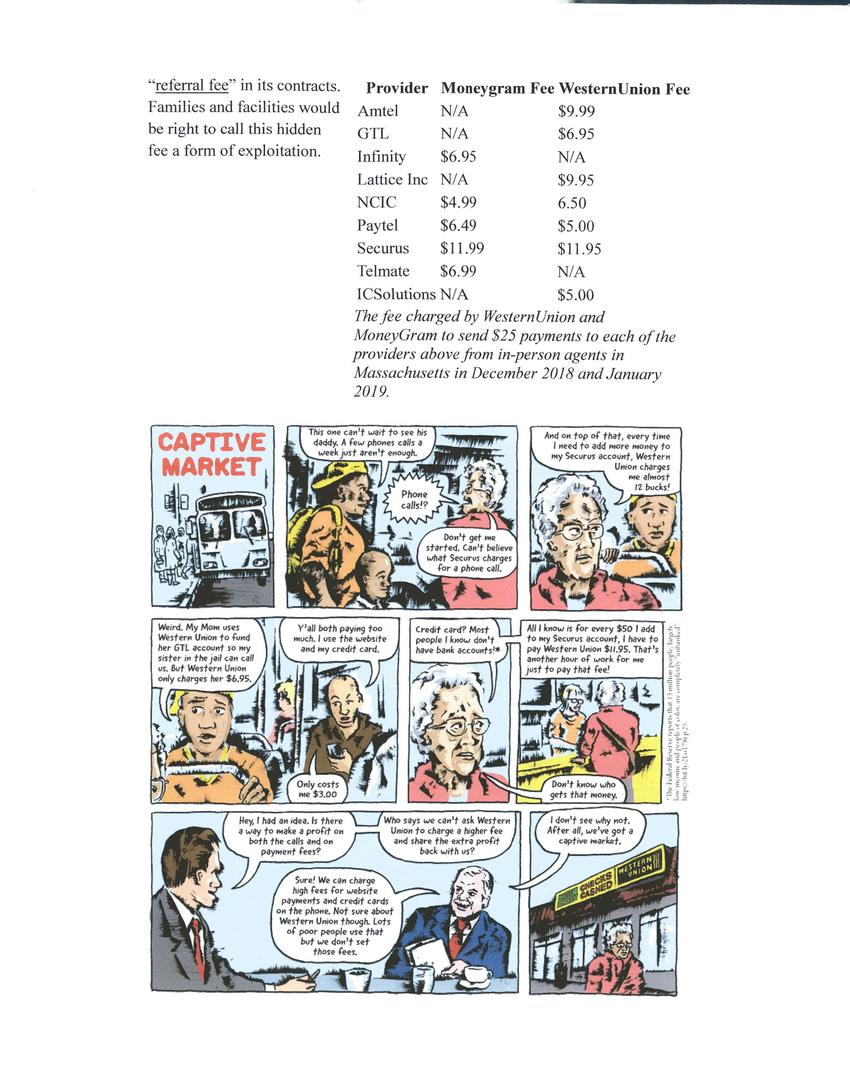
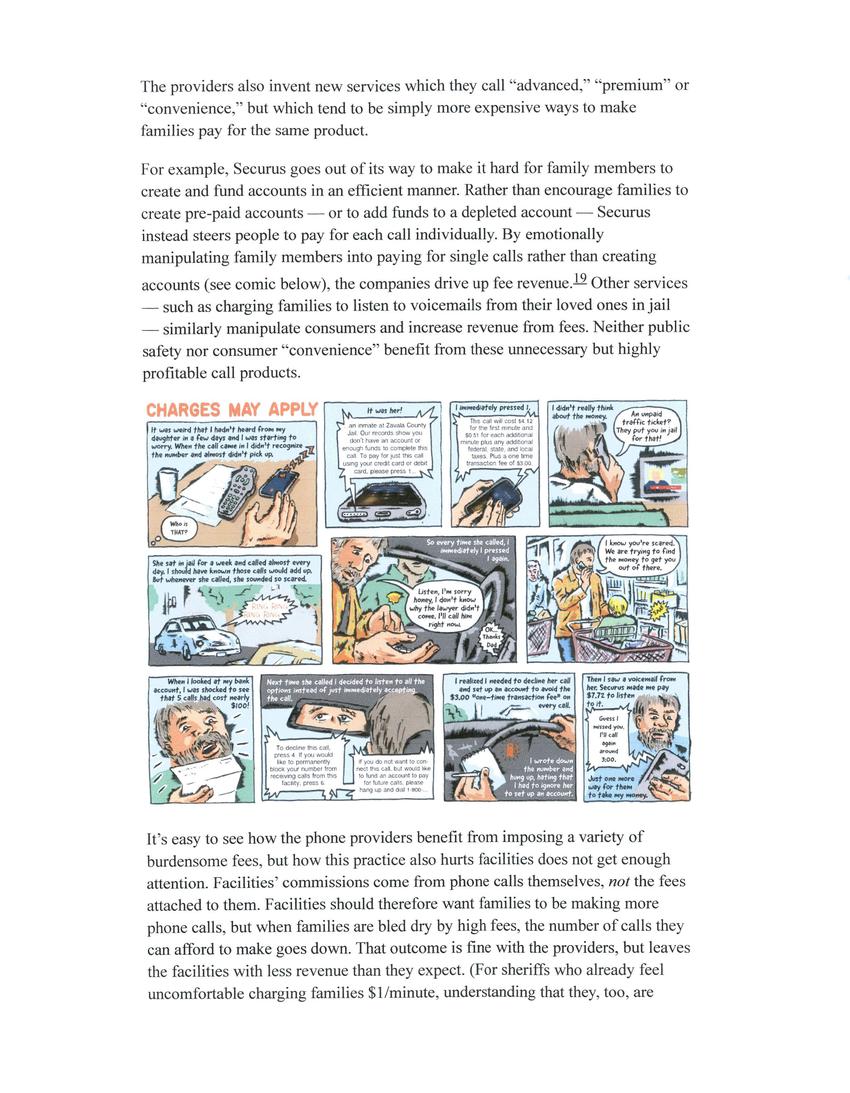

Replies